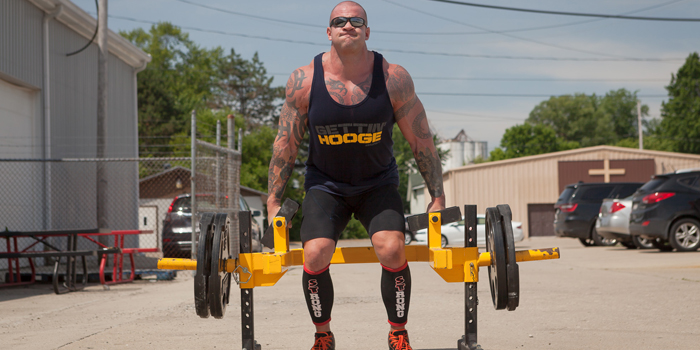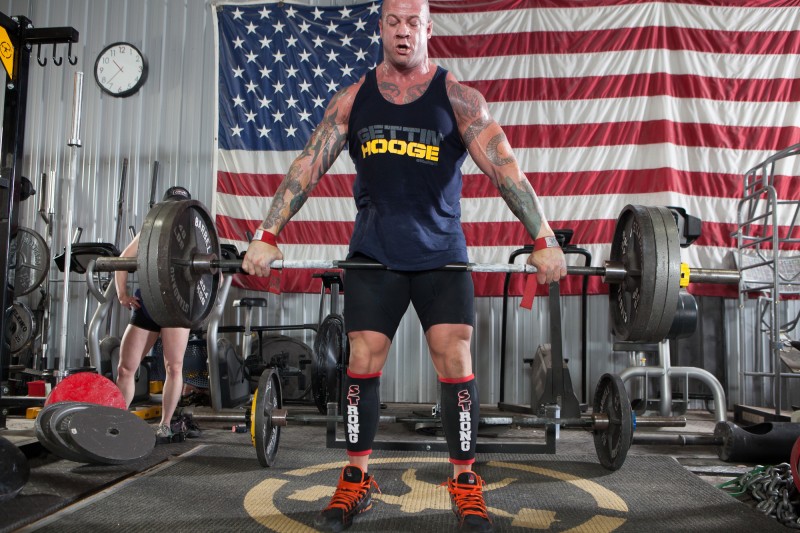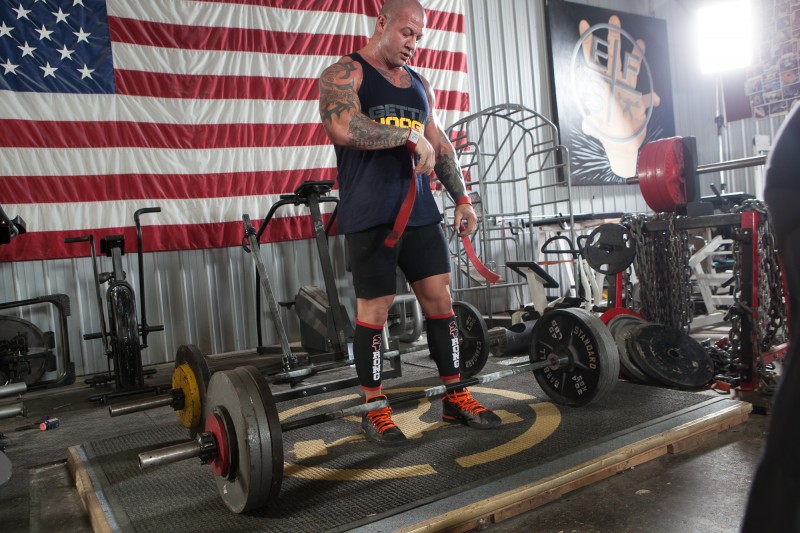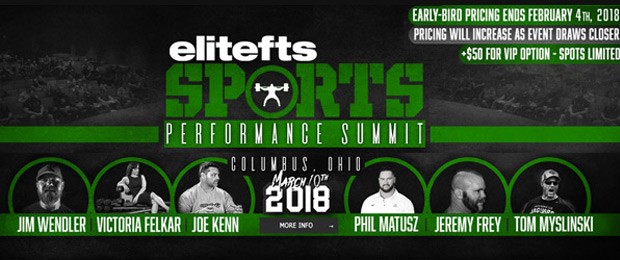
As an athlete and competitor in the strength sports, you may have heard a lot about specificity and accommodation. At a glance, these two concepts could not be farther apart from each other. At one end of the spectrum, we have specificity telling us that the things we do most often are the things we will become best at. On the other end, there’s accommodation telling us that the things we do most often become stale to us and will eventually make us weaker. Now, I’ve taken some liberties and paraphrased a bit on these concepts for simplicity’s sake, but they seem to be as different as Marvel and DC comics in the exercise science universe. While they may seem like polar opposites, these theories are actually both correct — it’s only a matter of when and how you apply them to your training that makes them both right.
Accommodation: A Vegas Buffet
Think of accommodation as the base of your sports performance pyramid. We want this base to be as wide as possible since the wider the base, the taller the peak. In the strength sports, this base consists of pure strength, but how can you quantify "pure strength?" Is it a strong deadlift or squat, since those are total body lifts? Is it a strong overhead press, since that is the king of upper body lifts? A strong yoke run, since it’s a more dynamic movement? A strong machine biceps curl because… just kidding.
RECENT: Bigger Is Not Always Stronger: Fallacies of Muscle Hypertrophy for Strength Athletes
The correct answer is all of them. Being strong across a broad spectrum of static and dynamic lifts is not only a wide strength base, but a solid one too. This is the definition of accommodation: building strength that is not specific to one or two movements but built across multiple physical and movement facets through varied training means and conditions.
Specificity: That Friend Who Only Wants to Eat Chipotle
If accommodation is the base of our pyramid then specificity is the peak. It’s true that the things we do most often are the things we become best at — to an extent. This specificity can only take us as high as our base is wide. So if I’m not very strong and I specialize in the bench press, for example, I will see great gains in a short amount of time by only doing work on my bench press. However, it wouldn’t take long for my strength gains to slow, stall, and then reverse, because my peak was only as high as the base I built under it. Now, if I’m a very strong individual I will also see great gains in strength from specializing in a given lift, but my peak will be much higher because I’m starting with a larger base compared to the hypothetical weaker version of me (the real version of me is pretty weak too, just sayin’).
The takeaway from all this is patience. Play the long game in your strength sport and take the time to build a large solid base by preventing your body from accommodating to your training. Accomplish this by training many different physical strengths and movement facets with varied training means and conditions. You will sacrifice a few podium finishes early in your sporting career for numerous podium finishes in the middle and later phases.
Preventing Accommodation
If accommodation is the state where our bodies get used to something, variety is the kryptonite to accommodation. I believe a conjugate system of training is best suited to facilitate this type of concurrent training variety. The best definition I’ve come across for the conjugate method comes from Managing the Training of Weightlifters: “The conjugate method consists of momentary influences on the key motor quality to the interconnections corresponding to the specific activity, while preserving the structure of the sport exercise1.”
This is essentially saying that training sessions should utilize a variety of special exercises and special developmental exercises to strengthen a specific competitive lift, in a specific training session, where the competitive lift itself is not necessarily trained. An example of this would be when a powerlifter uses floor presses as their main lift on their "bench press" training day, or an Olympic lifter that performs cleans from elevated blocks as the main lift on their "clean" training day. These exercises must be varied within the context of a concurrent training schedule, employing a combination of the maximal effort method, repetition method, variable method, interval method, or dynamic method while keeping some aspects of the form and function of the competitive lift in mind1,2. This is what is called the principle of dynamic correspondence; the further removed we get from the form, function, and energy system used in the competitive lift, the less transfer of training we get from these exercises2. No need to channel your inner college art student here — sometimes the smallest exercise variations can deliver the best results.
It is important to understand that this movement variety is not specific to just exercise selection but also the type of strength expressed in the selected exercises (speed-strength, strength-speed, explosive strength, etc.). This means the type of strengths required for the competitive lift must also be trained in variety using dynamic correspondence.
This training variability designed to prevent accommodation must also be applied to the accessory work performed in a training session. These exercises are designed to attack weaknesses in the competitive main lift on that training day. Using our bench press example, let’s say the lifter struggles with their lockout, which indicates weak triceps. This lifter's accessory work should be varied and selected around strengthening this weakness. For these accessory lifts, don’t set out to create A Clockwork Orange, Picasso-inspired masterpiece, because at the end of the day the transferred training effect will be so low that it won’t make your competition lift any stronger. And then you’re just wasting your time.
Detailed programming to prevent accommodation is outside the scope of this article, but you can find specific information about programming to prevent accommodation in my article "Programming Economy." Here you’ll find an outline of exercise organization and volume for each training block leading up to a competition.

Implementing Specificity
The specifics about implementing specificity into your training can also be found in "Programming Economy." A general rule of thumb for intermediate lifters (no need to advise the top guys; something tells me they already have this stuff figured out) is to test their competition lifts four weeks out to see where they’re at, then spend the next two weeks focusing only on becoming as proficient with their competition lifts as needed to in order to determine realistic goals for their lifts on game day. The last week should act as a deload where they perform active recovery workouts the first few days of the week and then rest until the competition. For this intermediate level strength athlete who competes three times a year, this comes out to three calendar months of specificity training, which in the grand scheme of strength training still allows you to spend the bulk of your training time building your strength base.
WATCH: Table Talk — How to Run a Three-Day Conjugate Training Split
For the novice lifter, the rule is to test their competition lifts three weeks out to see where they stand and then spend the next week focusing on proficiency to give them an idea of an attainable goal to shoot for. They would then deload in the last week just like the intermediate lifter. This novice athlete needs to gain competition experience, so I suggest they compete four times a year. This gives the novice lifter three calendar months of specificity training, leaving plenty of time to continue getting stronger while still giving enough opportunities to gain invaluable competition experience.
The biggest problem I see in the strength sports is when athletes specialize too far in advance of a competition. Initially, they will see great results, thinking they have it all figured out, and then accommodation creeps in and their numbers drop or injuries start to occur. More often than not they compete and hit numbers far below what they should have if they had not specialized so quickly. Most of these athletes then believe they didn’t work hard enough and come back for their next competition specializing even further out with higher training volumes and intensities, which only makes the cycle repeat itself to a greater degree. Use these time frames I’ve listed above for optimal sporting performance. If you choose to specify outside of those time frames, you’re asking for the accommodation ninja to roundhouse kick you in the face for the KO.
In the End
Accommodation and specificity are yin and yang to each other in the strength world. Both concepts can serve every strength athlete depending on how they are used in everyday and overall training. As with anything in this world, too much of one thing is not a good thing. By taking these concepts and applying them to your training you’ll set yourself on a path of sporting achievements and longevity. In the end, that’s what competing is all about, right? Lifting at the highest level possible for the longest time possible. So become the Benjamin Button of your sport by using accommodation and specificity correctly and when you retire you’ll leave your competitors wondering how you were so good for so long.
References
- Laputin N.P. Oleshko V.G. Managing the Training of Weightlifters. Livonia, MI: Sportivny Press; 1982.
- Verkhoshansky Y.V. Fundamentals of Special Strength Training in Sport. Livonia, MI: Sportivny Press; 1986
Mark Clevenger's professional experience includes being a current Light Weight Strongman Corporation and United States Strongman competitor, as well as the current head sports performance coach for the dedicated strongman training group Louisville Strongman. His former professional experience includes varsity football at Depauw University, being a CrossFit coach, high school football coach, and eight years of military service. Mark's education and certifications include being a current doctoral student, finishing his Doctor of Physical Therapy degree at Nova Southeastern University, bachelors in Kinesiology acquired from Depauw University, and currently holding his CSCS from the NSCA. Check out his website at https://louisvillestrongman.com/.










